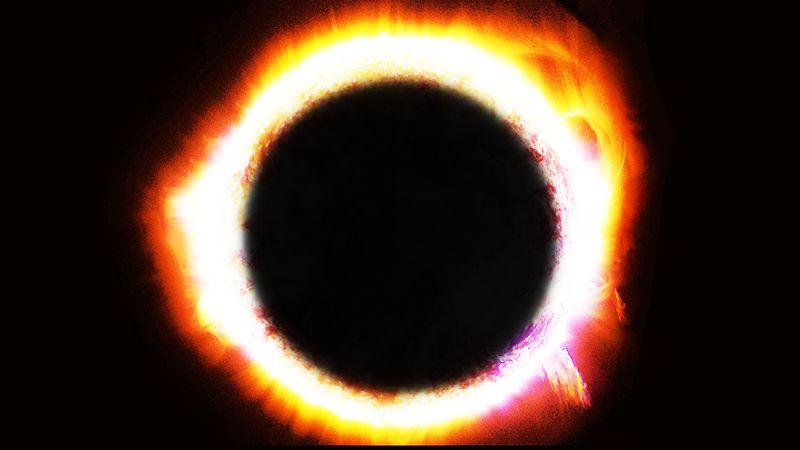The upcoming solar eclipse, set to occur on October 14, 2023, is not your average eclipse; it will create a stunning “ring of fire” effect in the sky, and it’s a prelude to an even more spectacular total solar eclipse that will grace the skies.
Table of Contents
On the horizon, a celestial spectacle is about to unfold that will leave skywatchers in awe. In this article, we’ll dive into the details of this rare event, including why eclipses happen, the last occurrence, future predictions, the significance of the “ring of fire,” and how to safely observe this cosmic phenomenon.
The Mechanics of Eclipses: Why Do They Happen?
Solar eclipses occur when the moon passes between the Earth and the sun, partially or completely blocking the sun’s light. An annular eclipse, like the one set to take place in 2023, happens when the moon is at its farthest point from Earth (apogee). Due to this added distance, the moon appears smaller than the sun, creating a “ring of fire” effect, where the sun’s edges are still visible.

The Last Solar Eclipse and Future Predictions
The last solar eclipse in the United States happened in 2017, while the last annular eclipse that crossed over the contiguous United States was in 1994. As for future eclipses, it will be 2039 before another “ring of fire” eclipse is visible in the U.S., and Alaska will be the only state within its path. It will take until 2046 for another annular eclipse to cross into the U.S. Lower 48.
A Path of Celestial Wonder “Ring of Fire”
The path of this eclipse is a visual treat. It begins in the North Pacific, entering the United States in Oregon, and culminating in the “ring of fire” a little over an hour later. From there, it makes its way down through Nevada, Utah, New Mexico, and Texas, touching parts of Idaho, California, Arizona, and Colorado before exiting into the Gulf of Mexico at Corpus Christi. This breathtaking journey takes less than an hour for the fiery halo to traverse the U.S.
Beyond the United States, the “ring of fire” will continue its journey, crossing over Mexico’s Yucatan Peninsula, Belize, Honduras, Nicaragua, Costa Rica, Panama, Colombia, and finally, Brazil, where it will reach its grand finale over the Atlantic.
Who Can Witness the Eclipse and When?
Millions of people in the Americas will have a front-row seat to this rare celestial event. More than 6.5 million people live along the path of annularity in the United States, with an additional 68 million within 200 miles of the path. This means that over 70 million people can witness this incredible alignment with just a few hours’ drive.
The maximum duration of the annular phase of the October 14, 2023 solar eclipse will be 4 minutes and 33 seconds, occurring at 11:34 AM Central Time (CDT) in the town of Quemado, Texas. The eclipse will begin at 10:23 AM CDT and end at 12:45 PM CDT.
Here are the timings of the eclipse at few locations in the Americas:
| Location | Maximum Duration | Eclipse Begins | Annular Phase Begins | Annularity Maximum | Annular Phase Ends | Eclipse Ends |
| Quemado, Texas, USA | 4 minutes 33 seconds | 10:23 AM CDT | 11:15 AM CDT | 11:34 AM CDT | 11:53 AM CDT | 12:45 PM CDT |
| Albuquerque, New Mexico, USA | 4 minutes 28 seconds | 10:34 AM MDT | 11:26 AM MDT | 11:35 AM MDT | 11:44 AM MDT | 12:56 PM MDT |
| San Antonio, Texas, USA | 4 minutes 19 seconds | 10:52 AM CDT | 11:44 AM CDT | 11:54 AM CDT | 12:04 PM CDT | 1:16 PM CDT |
A crescent-shaped partial eclipse will be visible in every U.S. state, albeit barely in Hawaii, provided the skies are clear. Canada, Central America, and most of South America will also get to see a partial eclipse, with the magnitude of the eclipse increasing closer to the “ring of fire” path.
Protecting Your Eyes During the Eclipse
Safety should be a top priority when witnessing a solar eclipse. It’s crucial to use safe, certified solar eclipse glasses to protect your eyes. Regular sunglasses are not sufficient to prevent eye damage. Ensure that you have proper eye protection for the entire duration of the eclipse, from the initial partial phase to the “ring of fire” and the final partial phase.
If you don’t have eclipse glasses, you can observe the eclipse indirectly using a pinhole projector, which you can easily create, even from a cereal box. Keep in mind that cameras, binoculars, or telescopes need special solar filters mounted at the front end to prevent damage to the equipment and your eyes.
A Scientific and Cultural Extravaganza
This solar eclipse offers a unique opportunity for scientific observation. NASA and other organizations plan to conduct various experiments during both this eclipse and the upcoming one in 2024. Rockets and balloons will soar into the sky to study atmospheric changes, making this an extraordinary moment for scientific discovery.
Additionally, this eclipse coincides with art, music, and river festivals in some locations, turning the celestial event into a cultural extravaganza. It’s not just a feast for the eyes; it’s an opportunity to celebrate and learn about the wonders of our universe.
The upcoming “ring of fire” eclipse is a celestial event that should not be missed. Whether you’re a seasoned astronomer or just curious about the cosmos, this eclipse offers a once-in-a-lifetime opportunity to witness the beauty of our solar system in action. Remember to protect your eyes, enjoy the show, and mark your calendars for the total solar eclipse in April 2024, promising another mesmerizing display of the universe’s grandeur.
For some fortunate locations, such as Kerrville in Texas, this year offers a rare celestial doubleheader. Kerrville is positioned in the path of both the 2023 and the 2024 eclipses. The city is buzzing with excitement, and Mayor Judy Eychner believes that the population of 25,000 could double or even quadruple during the eclipse festivities. In addition to local celebrations, NASA will be hosting a livestream of the event from Kerrville, enhancing the experience for those who can’t make it to the location.
As we gather to witness the celestial dance of the moon and sun, it’s worth noting that solar observations have never been more advanced. Even Aditya L1 was also launched to observe the sun. In fact, it is India’s first solar mission. Aditya L1 is currently in orbit around the Lagrange point 1 (L1) of the Sun-Earth system, which allows it to continuously view the sun without any eclipses or obstructions. This groundbreaking mission provides a continuous stream of data and images, helping scientists further understand our star and its impact on our planet.
Eclipses for Science and Discovery
The scientific value of eclipses is immeasurable. NASA and numerous other organizations plan to use these events to gather data and perform experiments. In 2023, scientists will launch rockets and balloons to study atmospheric phenomena. The goal is to understand how eclipses can create waves in the ionosphere, a region of Earth’s atmosphere about 200 miles above the surface. These waves could potentially affect communication systems, making this a significant opportunity for research and discovery.
Aroh Barjatya, from Embry-Riddle Aeronautical University, will be launching rockets as part of these scientific endeavors. He’ll be outside the “ring of fire” but is eagerly anticipating the scientific insights these missions will provide.
The upcoming “ring of fire” eclipse is a spectacle that unites science, culture, and the marvels of the universe. It’s a reminder of our planet’s place in the solar system and a testament to the incredible precision of celestial mechanics. Don’t miss the chance to witness this breathtaking event, and remember to do so safely. Whether you’re a seasoned eclipse chaser or a first-time observer, this is a moment that will leave an indelible mark on your memory.
As you prepare to experience the solar eclipse, take a moment to reflect on the vastness of our universe and the wonders it continues to unfold. From the “ring of fire” in 2023 to the total solar eclipse in 2024 and beyond, these celestial events are a reminder that there is still so much to explore and understand in the cosmos. Enjoy the show and embrace the beauty of our universe as it unfolds before your eyes. And as we do, we can appreciate the contributions of missions like Aditya L1, which keep a constant eye on our life-giving star, providing valuable insights into its behavior and influence on Earth.
Read More: Solar Storm In 2023: Are We Headed For An Internet Apocalypse ?
Read More: Breakthrough 2023: LK-99 World’s First Room Temperature Superconductor Achieved
Read More: Top 10 Kitchen Gadgets On Amazon In 2023! Every Kitchen Chef Must Have!
Read More: Aditya L1 Launch Soars To The Skies: India’s Remarkable Solar Mission Takes Flight






